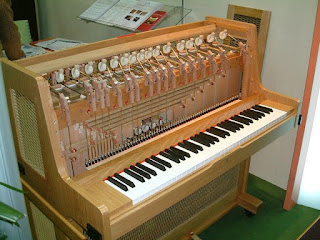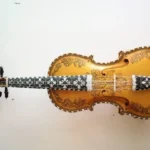
The celesta is a musical instrument from the percussion family, but it is frequently found in an orchestra’s keyboard section. The celesta resembles a piano or a large music box, and sound is produced by keys striking hammers, which then strike metal plates suspended over resonators. Instruments with three octaves or less do not have pedals, but those with four or five octaves or more usually do. The name ‘celeste’ means ‘heavenly’ in French and was given to the instrument because of the soft sound it produces. Tchaikovsky’s “Dance of the Sugar Plum Fairy” is probably the most famous composition with the celesta. Ernest Chausson was the first to use the celesta in a small orchestra composition in 1888.
Interesting facts about Celesta:
The celesta is credited to Parisian harmonium player Auguste Mustel and his father Victor Mustel as its creators. From an earlier version of an instrument called the typophone that his father Victor had created in 1860, Auguste created the celesta in 1886.
The typophone’s sound and functionality were constrained because it didn’t have metal plates like the celesta did.
Typically, steel is used to construct the sound bars for celestas. The hammers above are struck by the keys on the keyboard, which then strike the steel. On hollow wood resonators, the steel bars are supported. Rich, warm, and mellow describe the sound.
The celesta can be played similarly to a piano using keys and a pedal. When playing, the pedal is used to amplify the notes’ sound.
The celesta has a sound that is similar to the glockenspiel but warmer and rounder.
The celesta does not have the same dynamic range as a piano and does not produce loud sounds.
The celesta is typically used for passages that are intended to sound gentle and soft because, when played hard, it produces piercing music.
The harp, high string, and woodwind instruments are frequently combined with the celesta.
Pyotr Tchaikovsky’s symphonic poem The Voyevoda from 1891 was the first significant symphonic work to feature the celesta.
In The Nutcracker, one of the most well-known ballets in history, Tchaikovsky used the celesta.
An American in Paris by George Gershwin, Morton Feldman’s For Philip Guston, and Gustav Mahler’s Symphony No. 6 are among the well-known compositions that use the celesta.
Other than orchestras and classical music, the celesta is also used in other types of music. Earl Hines, Fats Waller, Duke Ellington, Oscar Peterson, and Herbie Hancock have all included it in their jazz compositions.
Rock, pop, and pop-rock musicians have all used the celesta in their compositions today. These musicians and bands have included Rod Stewart, Pink Floyd, Buddy Holly, The Beatles, The Association, The Beach Boys, and Fiona Apple.
The celesta was used for the song Pure Imagination that Gene Wilder sang in the movie Willie Wonka & the Chocolate Factory in 1971.
Some of the music for Mr. Rogers’ Neighborhood, a children’s television program, was composed using the celesta.
Celesta FAQs: Unveiling the Sound of a Heavenly Instrument
The celesta, with its enchanting, bell-like sound, has captivated musicians and audiences for over a century. Here are some commonly asked questions to illuminate this unique instrument:
What is a Celesta?
- The celesta is a keyboard instrument belonging to the percussion family. Despite its keyboard layout, it shares more similarities with instruments like the glockenspiel or metallophone due to its sound production method.
How Does a Celesta Work?
- When a key is pressed, a felt hammer strikes a metal plate, producing a soft, high-pitched sound. The sound resonates within a wooden box, creating its characteristic tone.
- Unlike a piano, the celesta does not have strings. The metal plates come in various sizes, corresponding to different musical pitches.
What Does a Celesta Sound Like?
- The celesta’s sound is often described as ethereal, bell-like, or even celestial (hence the name, “celesta” meaning “heavenly” in French). It has a delicate, shimmering quality that adds a touch of magic to orchestral pieces.
Who Invented the Celesta?
- The celesta was invented in 1886 by Parisian harmonium maker Auguste Mustel. He was inspired by existing instruments like the glockenspiel but wanted a softer, more nuanced sound.
What is the Range of a Celesta?
- The celesta typically has a range of four to five octaves, offering flexibility for composers.
Is the Celesta Difficult to Play?
- Anyone familiar with the piano can learn the basics of playing the celesta due to the shared keyboard layout. However, mastering the subtle nuances of producing the desired sound with the pedals and proper hand technique takes practice.
Where is the Celesta Used?
- The celesta is primarily used in orchestral settings.
- One of the most famous uses of the celesta is in Tchaikovsky’s “The Dance of the Sugar Plum Fairy” from the Nutcracker ballet.
- It can also be found in contemporary music scores, adding a touch of whimsy or otherworldly ambience.
Are Celestas Expensive?
- Celestas are relatively expensive instruments due to their handcrafted nature and limited production. Prices can range from tens of thousands to hundreds of thousands of dollars.
Can I Hear a Celesta?
- Absolutely! Many classical music recordings featuring orchestral pieces likely include the celesta. You can also find solo celesta performances or pieces featuring the instrument prominently online or on music streaming services.
Interesting Facts About the Celesta:
- The celesta’s soft sound can sometimes be overwhelmed by louder instruments in an orchestra. Therefore, composers often place it strategically or use other techniques to ensure its delicate notes are heard.
- Despite its delicate sound, the celesta is a surprisingly sturdy instrument. The metal plates are quite durable, and the overall build is designed to withstand the rigors of orchestral performance.
Hopefully, this FAQ has enlightened you about the unique world of the celesta. Its enchanting sound and rich history continue to hold a special place in the musical landscape.









